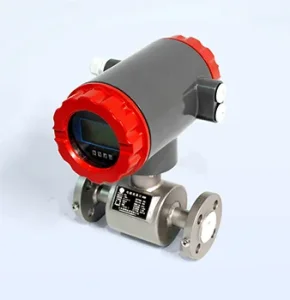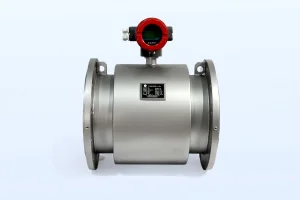
磁気流量計 ファラデイの法則と呼ばれるきれいなトリックを使って、管の中で液体がどれだけ速く動くかを判断します。この法則は、液体が磁場を通過するときの電気信号を測定します。液体は通常少なくとも5 µS/cmの電気を導かなければなりません。メーターには磁場と電極と呼ばれる小さなセンサーがあり、これらの信号を捕捉します。これらは液体がどれだけ速く移動しているかを示しています。メーターは,PTFEやゴムのような堅いライナー,Hastelloyのような強い電極を使用して粗い液体を処理します.トランスミッターと呼ばれるスマートボックスは、信号を読みやすいデータに変える。 磁気流量計 水、廃水、化学工場にとって素晴らしいです。正確で、あまり固定する必要はなく、制御システムに適合します。最良の結果を得るには,それらを正しく設定し,良い接地,適切なパイプ方向,そして直いパイプセクションを持つ必要があります.
磁気流量計 ファラデイの電磁誘導法則 Faraday's Law of Electromagnetic Inductionこれは、電気を運ぶ液体が磁場を通過するときに微小な電圧を作ると言う。液体は移動する線のようです。磁場はパイプを交差し,側面の電極は電圧を捕捉します.この電圧は、液体がどれだけ速く動くかに一致します。流量を得るには、パイプのサイズで速度を乘えます。これにより 磁気流量計 流れをチェックするための超信頼性があります。
液体はこれらのメーターが動作するために電気を運ぶ必要があります。よく導く液体のみが正しく測定するのに十分に強い電圧を作ります。液体の伝導率があまりにも低い場合、例えば5µS/cm未満の場合、信号は弱すぎます。だから 磁気流量計 水や同様のもののために素晴らしいですが、オイルや超クリーンな水のためではありません。特別なメーターは伝導性が低い液体を処理することができますが、それらは一般的ではありません。
磁場は安定して滑らかでなければなりません。パイプの周りのコイルはこのフィールドを作ります。固体場とは、電圧はフィールドの振動ではなく、液体の動きからのみ来ることを意味します。これにより,液体が混乱的に流れたとしても,測定は正直に保ちます.
電極はパイプのライナーの内部に置かれて、移動する液体からの電圧を受け取ります。A で 磁気流量計液体の速度は電圧、電極間の空間、磁場の力から来ます。ハステロイのような堅い材料は、ハハステロイを止め、信号を明確に保つ。それらを慎重に配置すると、他の電気の他の他のノイズを避けるため、信号は実際の流れを示します。
メーター内部の流れ管は,壊れずに厳しい液体に立ち向かなければなりません.PTFE、PFA、またはゴムのようなライナーは、強い酸やチャンキーなスラリーのような液体に一致するように選択されます。良いライナーはメーターを何年も滑らかに動かせます。
各ライナーは異なる仕事に適しています。PTFEは厳しい化学物質を取り除く。硬いゴムは、粗く、粗い液体を処理します。セラミックライナーは非常に熱い液体で動作します。間違ったライナーを選ぶと、時間の経過とともに精度を混乱させたり、メーターを壊すことができます。

モデルを選ぶことができます。 磁気流量計 DN15 から DN300 から チェンシュオこれらは小さなパイプから巨大な都市水システムまで多くの仕事に役立ちます。あらゆる種類の作業を簡単に処理できるように設計されています。

電極の設定方法は、メーターが信号をどれだけよく捉えるかを変える。バランスの取れた設定により、不均等な流れからのエラーが減少します。これにより、液体が回転したり、急流したりしても、メーターを安定させます。
化学物質や固体ビットを持つような粗い液体では、ハステロイやプラチナのような物質で作られた電極が最適です。フラッシュ電極は蓄積を止め、汚れた液体でさえ清潔に維持します。
トランスミッターは電極信号を捕捉し、それらを有用な情報に変える。彼らはスマートな数学を使ってノノノイズを除去し、データが正しいことを確認します。
トランスミッター内の特別回路は不要な信号スパイクをブロックします。アナログからデジタルへの変換器は,医薬品や食品工場などの場所にとって重要なデータを明確で正確にします.
新しいトランスミッターは,信号の漂移を自動的に固定し,多くのポイントで精度をチェックするなどのきれいなトリックを持っています.これらは、条件が変わっても、メーターが良く動作するのを助けます。 チェンシュオの 磁気流量計 システムはこれらのスマートな機能を持っています。
A 磁気流量計 汚い、厚い、または酸性のものでも多くの液体を処理できます。しかし,超純水のような液体がほとんど電気を持ち込んでいない場合,良い読み取りを得るために特別な方法が必要かもしれません.
一部の企業、例えば チェンシュオ二重周波刺激または低伝導性液体を測定する他の方法でシステムを作ります。これにより、メーターは難しい場所で動作します。
高熱はライナーの形状を曲げることができ、強い圧力は電極またはシールを曲げることができます。スマートトランスミッターはセンサーを使用してこれらの問題を修正し,読み取りを真実に保つ.
いくつかのデザインは,メーターを熱から保護するために絶熱を使用します.温度変化に対して調整するソフトウェアもありますので,メーターは熱い設定で信頼性を持っています.
パイプが間違って設定されている場合、空気泡や汚れは電極を混乱させることができます。良い接地は,読み取りを破壊する電気を止めます.電極は流れを確認するために液体に触れます。
非金属パイプの接地リングを使用します。変動周波数ドライブのようなものからメーターを離してください。電源線から信号ケーブルを離れてノノノイズを削減します。
液体がスムーズに流れるには、メーターの前に5〜10個の直径の直径のパイプ、その後に3〜5個の直径が必要です。周辺の曲折、バルブ、ポンプから離れてください。
工場はISOやOIMLのようなルールを使用して、正確なツールでメーターを設定します。フィールドでは、ポータブルガジェットは作業を停止することなくメーターをチェックします。
追跡可能な校正は,検査中にメーターがルールに従うことを示します.問題を早期に発見するため、問題を引き起こす前に修正できます。
モダンな 磁気流量計 電極テストやコイルチェックのようなツールで自分自身を確認します。メーターの状態を知るためにこれらを遠隔から見ることができます。動く部品がなく、これらのメーターはほとんど注意を必要としません。
HART®、Modbus®、Profibus®などのプロトコルにより、メーターは制御システムにリンクできます。これはリアルタイムのデータを提供し、過去のパフォーマンスを追跡します。
無線送信機やクラウドダッシュボードでメーターを選択します。これらは、どこからでもメーターがどのように動いているかを確認し、修正が必要なときを推測できます。
廃水プラントでは,固体や厚さの変化を伴う汚れた液体を処理します.厳格な規則の下で水の流れを追跡するのに最適です。
化学工場は高温で厳しい液体を使用します。メーターには特別なライナー,電極,危険な地域のための安全なカバーが必要です. チェンシュオ これらの仕事のためにカスタマイズできるオプションがあります。
FDA認可のライナーを備えた衛生計は,クリーンインプレースシステムで動作します.食品安全規則を満たすためにバッチ記録を保存します。
強く信頼したいなら 磁気流量計, 山東 Chenshuo 機器 Co.、株式会社 水処理,エネルギーシステム,HVAC,または化学用量などの難しいタスクのための大きな範囲を提供します.彼らのメーターは、堅固な構造とスマートな電子機器を混合しています。サポートチームは、あなたがどこにいても、電話やメールで常に助ける準備ができています。
Q1: 磁気流量計は石油のような非伝導性流体を測定できますか?
A:いいえ。 磁気流量計 電気を運ぶ液体が必要です。オイルや超純度の水は、測定するのに十分な信号を与えません。
Q2:これらのデバイスで頻繁なメンテナンスが必要ですか。
A:あまりない。動く部品なし、A 磁気流量計 他のメートルに比べて少ない固定で長く続きます。
Q3:これらのメーターを垂直に設置することは可能ですか。
A: はい。垂直設定は,接地とパイプ長さのルールに従う場合に機能します.時には汚れが生まれるのを止めることもできます。